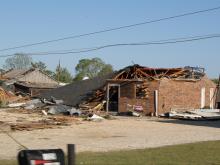- Storm damage forces recovery efforts in Lancaster, Chester counties
- Evacuation orders lifted as fast-moving New Jersey wildfire burns
- Heartbreak for NC resident as wildfire reduces lifetime home to ashes
- ‘It’s only going to get worse’: Wildfire risk grows in western North Carolina
- McDowell County wildfire spreads to 2,085 acres
Researchers want to hear your 'tornado tale' to improve weather warnings

Patti Clapper was watching WRAL-TV the afternoon of April 16, 2011. From her home near Holly Springs, she listened to meteorologists Mike Maze and Nate Johnson as they tracked the largest one-day tornado outbreak on record in North Carolina.
“I heard Nate start mentioning streets,” Clapper said. “I heard him say the street right down the street from me.”
She called her children downstairs and looked out the window.
“I just saw this massive green, surreal, ‘Wizard of Oz’-looking thing, and I was like, ‘OK, everybody down!” Clapper said.
The family was building a new computer desk in the living room, so they pushed it together with the old desk and took shelter underneath.
“It seemed like an eternity,” she said. “We could hear it going through the backyard, could hear stuff hitting the house.”
Once the storm passed, the Clappers were OK. The house was still standing.
“My husband opens up the front door and says, ‘Oh my God,’” she remembers.
Trees had snapped through their wooded neighborhood. Some crushed their neighbors’ cars.
Thankfully, Clapper knew what to do when she received the tornado warning that day, but would you?
In many ways, we’re better protected from severe weather than ever before. Our detection tools here in the WRAL Severe Weather Center, like Dual Doppler 5000 radar, give us the ability to spot and track dangerous storms. Thanks to smartphones, you can get life-saving alerts from the WRAL Weather app any time, anywhere.
However, receiving a warning is only part of protecting yourself.
“A warning can be issued for your area, but you have to know what to do,” said WRAL meteorologist Aimee Wilmoth.
Researchers have been studying how people react to weather alerts for decades. Scientists with the National Oceanic and Atmospheric Administration (NOAA) need your help to advance their knowledge. They recently launched “Tornado Tales,” an online survey asking people anonymously about their experiences with tornadoes. They also want to hear how you have responded to tornado warnings or even strong thunderstorms that made you worried about tornadoes.
“What we’re hoping is that this information can help NOAA identify areas where NOAA messages may not be resulting in the most safe and effective actions,” said Dr. Justin Sharpe, a research scientist with NOAA’s National Severe Storms Laboratory in Norman, Oklahoma. “That will help NOAA hone its safety messages and improve, hopefully.”
In addition to creating more effective watch and warning messages, Sharpe hopes the research can open broader discussions about sheltering options in communities. He said researchers are especially interested in learning what sheltering choices people had available during tornado warnings and situations where people did not have good options.
Sharpe hopes that some time next year, researchers can begin reporting findings. He also hopes the survey can run for many years, giving NOAA more insight into effective watch and warning messages. Sharpe envisions learning about regional differences in how people respond, possibly leading to specific messages targeting different areas.
Clapper won’t forget the 2011 tornado or the several months of clean-up that followed. The storm made Clapper take severe weather more seriously.
“Pay attention and listen to the weather people,” she said. “Do what they tell you to do.”